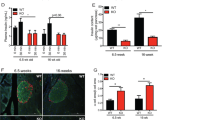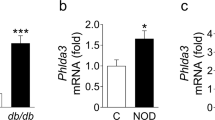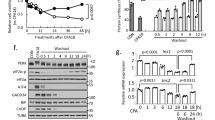Abstract
Endoplasmic reticulum (ER) stress causes pancreatic β-cell dysfunction and contributes to β-cell loss and the progression of type 2 diabetes1,2. Wolfram syndrome 1 (WFS1) has been shown to be an important regulator of the ER stress signalling pathway3; however, its role in β-cell function remains unclear. Here we provide evidence that WFS1 is essential for glucose- and glucagon-like peptide 1 (GLP-1)-stimulated cyclic AMP production and regulation of insulin biosynthesis and secretion. Stimulation with glucose causes WFS1 translocation from the ER to the plasma membrane, where it forms a complex with adenylyl cyclase 8 (AC8), an essential cAMP-generating enzyme in the β-cell that integrates glucose and GLP-1 signalling4. ER stress and mutant WFS1 inhibit complex formation and activation of AC8, reducing cAMP synthesis and insulin secretion. These findings reveal that an ER-stress-related protein has a distinct role outside the ER regulating both insulin biosynthesis and secretion. The reduction of WFS1 protein on the plasma membrane during ER stress is a contributing factor for β-cell dysfunction and progression of type 2 diabetes.
This is a preview of subscription content, access via your institution
Access options
Subscribe to this journal
Receive 12 print issues and online access
$209.00 per year
only $17.42 per issue
Buy this article
- Purchase on Springer Link
- Instant access to full article PDF
Prices may be subject to local taxes which are calculated during checkout





Similar content being viewed by others
References
Laybutt, D. R. et al. Endoplasmic reticulum stress contributes to β cell apoptosis in type 2 diabetes. Diabetologia 50, 752–763 (2007).
Huang, C. J. et al. Induction of endoplasmic reticulum stress-induced β-cell apoptosis and accumulation of polyubiquitinated proteins by human islet amyloid polypeptide. Am. J. Physiol. Endocrinol. Metab. 293, E1656–E1662 (2007).
Fonseca, S. G. et al. WFS1 is a novel component of the unfolded protein response and maintains homeostasis of the endoplasmic reticulum in pancreatic β-cells. J. Biol. Chem. 280, 39609–39615 (2005).
Delmeire, D. et al. Type VIII adenylyl cyclase in rat β cells: coincidence signal detector/generator for glucose and GLP-1. Diabetologia 46, 1383–1393 (2003).
Marchetti, P. et al. The endoplasmic reticulum in pancreatic β cells of type 2 diabetes patients. Diabetologia 50, 2486–2494 (2007).
Takeda, K. et al. WFS1 (Wolfram syndrome 1) gene product: predominant subcellular localization to endoplasmic reticulum in cultured cells and neuronal expression in rat brain. Hum. Mol. Genet. 10, 477–484 (2001).
Fonseca, S. G. et al. Wolfram syndrome 1 gene negatively regulates ER stress signalling in rodent and human cells. J. Clin. Invest. 120, 744–755 (2010).
Karasik, A. et al. Genetically programmed selective islet β-cell loss in diabetic subjects with Wolfram’s syndrome. Diabetes Care 12, 135–138 (1989).
Riggs, A. C. et al. Mice conditionally lacking the Wolfram gene in pancreatic islet β cells exhibit diabetes as a result of enhanced endoplasmic reticulum stress and apoptosis. Diabetologia 48, 2313–2321 (2005).
Hardy, C. et al. Clinical and molecular genetic analysis of 19 Wolfram syndrome kindreds demonstrating a wide spectrum of mutations in WFS1. Am. J. Hum. Genet. 65, 1279–1290 (1999).
Ishihara, H. et al. Disruption of the WFS1 gene in mice causes progressive β-cell loss and impaired stimulus-secretion coupling in insulin secretion. Hum. Mol. Genet. 13, 1159–1170 (2004).
Yajima, H. et al. cAMP enhances insulin secretion by an action on the ATP-sensitive K+ channel-independent pathway of glucose signalling in rat pancreatic islets. Diabetes 48, 1006–1012 (1999).
Henquin, J. C. Triggering and amplifying pathways of regulation of insulin secretion by glucose. Diabetes 49, 1751–1760 (2000).
Idevall-Hagren, O., Barg, S., Gylfe, E. & Tengholm, A. cAMP mediators of pulsatile insulin secretion from glucose-stimulated single β-cells. J. Biol. Chem. 285, 23007–23018 (2010).
Seino, S. & Shibasaki, T. PKA-dependent and PKA-independent pathways for cAMP-regulated exocytosis. Physiol. Rev. 85, 1303–1342 (2005).
Holz, G. G. t., Kuhtreiber, W. M. & Habener, J. F. Pancreatic β-cells are rendered glucose-competent by the insulinotropic hormone glucagon-like peptide-1(7-37). Nature 361, 362–365 (1993).
Pinto, C. et al. Activation and inhibition of adenylyl cyclase isoforms by forskolin analogs. J. Pharmacol. Exp. Ther. 325, 27–36 (2008).
Roger, B. et al. Adenylyl cyclase 8 is central to glucagon-like peptide 1 signalling and effects of chronically elevated glucose in rat and human pancreatic β cells. Diabetologia 54, 390–402 (2011).
Holz, G. G., Heart, E. & Leech, C. A. Synchronizing Ca2+ and cAMP oscillations in pancreatic β-cells: a role for glucose metabolism and GLP-1 receptors? Focus on ‘regulation of cAMP dynamics by Ca2+ and G protein-coupled receptors in the pancreatic β-cell: a computational approach’. Am. J. Physiol. Cell. Physiol. 294, C4–C6 (2008).
Walz, H. A. et al. Beta-cell PDE3B regulates Ca2+-stimulated exocytosis of insulin. Cell Signal 19, 1505–1513 (2007).
Shen, J. & Prywes, R. Dependence of site-2 protease cleavage of ATF6 on prior site-1 protease digestion is determined by the size of the luminal domain of ATF6. J. Biol. Chem. 279, 43046–43051 (2004).
Kakiuchi, C. et al. Valproate, a mood stabilizer, induces WFS1 expression and modulates its interaction with ER stress protein GRP94. PLoS One 4, e4134 (2009).
Hatanaka, M. et al. Wolfram syndrome 1 gene (WFS1) product localizes to secretory granules and determines granule acidification in pancreatic β-cells. Hum. Mol. Genet. 20, 1274–1284 (2011).
Dachicourt, N., Serradas, P., Giroix, M. H., Gangnerau, M. N. & Portha, B. Decreased glucose-induced cAMP and insulin release in islets of diabetic rats: reversal by IBMX, glucagon, GIP. Am. J. Physiol. 271, E725–E732 (1996).
Dolz, M. et al. cAMP-secretion coupling is impaired in diabetic GK/Par rat β-cells: a defect counteracted by GLP-1. Am. J. Physiol. Endocrinol. Metab. 301, E797–E806 (2011).
Montana, E., Bonner-Weir, S. & Weir, G. C. Beta cell mass and growth after syngeneic islet cell transplantation in normal and streptozocin diabetic C57BL/6 mice. J. Clin. Invest. 91, 780–787 (1993).
Alarcon, C., Wicksteed, B., Prentki, M., Corkey, B. E. & Rhodes, C. J. Succinate is a preferential metabolic stimulus-coupling signal for glucose-induced proinsulin biosynthesis translation. Diabetes 51, 2496–2504 (2002).
Zinchuk, V. & Zinchuk, O. Quantitative colocalization analysis of confocal fluorescence microscopy images. Curr. Protoc. Cell Biol. (2008).
Acknowledgements
We thank M. Hara, Y. Adachi, Y. Murakami, L. Leahy, K. Sargent, B. O’Sullivan-Murphy, J. Hollister-Lock, J. Brown, K. Lipson, D. Ahern-Ridlon and X. Wang, for expert technical support; and C. Fonseca, S. Bonner-Weir and G. Waters for data discussions and comments on the manuscript. This work was supported by grants from the NIH (DK067493, DK016746, P60 DK020579, RR024992 and UL1 TR000448) and JDRF (11-2011-40) to F.U.
Author information
Authors and Affiliations
Contributions
S.F., J.G. and M.B. wrote the manuscript and together with F.U. and G.C.W. conceived the experiments. S.F. carried out most of the experimental work. M.B. and J.G. directed the research programme.
Corresponding author
Ethics declarations
Competing interests
The authors declare no competing financial interests.
Supplementary information
Supplementary Information
Supplementary Information (PDF 718 kb)
Rights and permissions
About this article
Cite this article
Fonseca, S., Urano, F., Weir, G. et al. Wolfram syndrome 1 and adenylyl cyclase 8 interact at the plasma membrane to regulate insulin production and secretion. Nat Cell Biol 14, 1105–1112 (2012). https://doi.org/10.1038/ncb2578
Received:
Accepted:
Published:
Issue Date:
DOI: https://doi.org/10.1038/ncb2578
This article is cited by
-
Therapeutic potential of endoplasmic reticulum stress inhibitors in the treatment of diabetic peripheral neuropathy
Metabolic Brain Disease (2023)
-
Scopoletin intervention in pancreatic endoplasmic reticulum stress induced by lipotoxicity
Cell Stress and Chaperones (2018)
-
Correction: Retraction: Wolfram syndrome 1 and adenylyl cyclase 8 interact at the plasma membrane to regulate insulin production and secretion
Nature Cell Biology (2015)
-
Editorial note: Integrating insulin secretion and ER stress in pancreatic β-cells
Nature Cell Biology (2015)
-
Multilevel control of glucose homeostasis by adenylyl cyclase 8
Diabetologia (2015)



